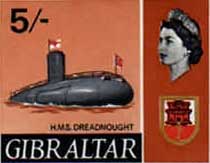HMS Dreadnought (S101)
|
|
The fourth HMS Dreadnought (S101) was the United Kingdom's first nuclear-powered submarine, built by Vickers of Barrow-in-Furness.
In 1955 the United States Navy completed USS Nautilus, the world's first nuclear-powered submarine. During subsequent exercises with the Royal Navy, Nautilus ran rings round British anti-submarine forces, who had developed extensive anti-submarine warfare techniques during the Second Battle of the Atlantic. The Admiralty decided to build nuclear-powered submarines.
Instead of developing an all-British nuclear submarine, much time and money would be saved by accepting the American lead and taking advantage of US nuclear technology. The excellent relations between Admiral Lord Louis, Earl Mountbatten, the First Sea Lord, and Rear Admiral Hyman Rickover, in charge of the American naval nuclear power program, expedited obtaining that help. Dreadnought was thus assembled from American parts in a Vickers-built hull. In particular, the reactor compartment and engineroom are almost entirely of US Navy design and construction and are known as the "American Sector".
Dreadnought was laid down on 12 June 1959, and launched by Her Majesty the Queen on Trafalgar Day, 21 October 1960. Dreadnought made her first dive, in Ramsden Dock, on 10 January 1963. At the time of her commissioning on 17 April 1963, she was one of the most formidable attack submarines in the world.
In the mid-1960s, Dreadnought's visits included trips to Norfolk, Virginia, Bermuda, Rotterdam, and Kiel. She was at Gibraltar in 1965, 1966, and 1967, and on 19 September 1967, she left Rosyth, Scotland for Singapore on a sustained high-speed run. The round trip finished as 4640 miles surfaced and 26545 miles submerged.
During her career, Dreadnought performed many varied missions. On 24 June 1967, she was ordered to sink the wrecked and drifting German ship Essberger Chemist. Three torpedoes hit along the length of the target, but the gunners of HMS Salisbury finished the job by piercing the tanks, which were keeping Essberger Chemist just afloat.
Apart from minor hull-cracking problems, Dreadnought proved to be a reliable vessel, popular with her crews. On 10 September 1970, she completed a major refit at Rosyth, Scotland, in the course of which her nuclear core was refuelled and her ballast tank valves were changed to reduce noise.
On 3 March 1971, Dreadnought became the first British submarine to surface at the North Pole. In 1973 she took part in the Royal Navy's first annual Group Deployment, when a group of warships and auxiliaries would undertake a long deployment to maintain fighting efficiency and "show the flag" around the world.
Together with the frigates Alacrity and Phoebe, Dreadnought was deployed to the South Atlantic in 1977 to deter possible Argentine aggression against the Falkland Islands. Due to machinery damage and the limited refit facilities then available for SSNs, Dreadnought was withdrawn from service in 1980.
Dreadnought is now at Rosyth Naval Dockyard, laid up indefinitely while her radioactive contamination decays. Her nuclear fuel has been removed and she has been stripped of useful equipment.
During Dreadnought's construction, Rolls Royce and Associates, in collaboration with the United Kingdom Atomic Energy Authority, developed a completely new nuclear propulsion system. On 31 August 1960, the UK's second nuclear-powered submarine was ordered from Vickers and, fitted with Rolls Royce's nuclear steam-raising plant, Valiant was the first all-British nuclear submarine.
See HMS Dreadnought for other ships of the name.



